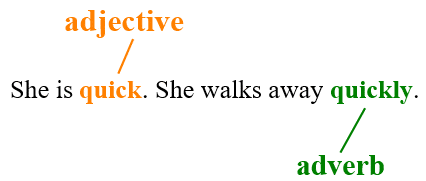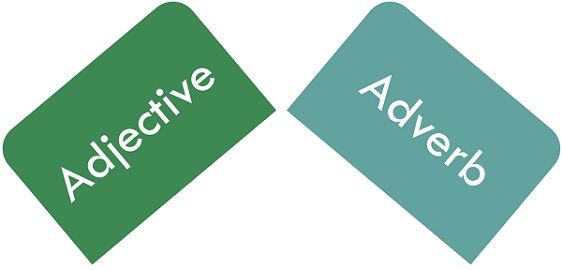
- She was extremely friendly to me, as she was talking to me politely.
- The librarian scolded us for talking loudly. He is a very disciplined person.
In the first sentence, you might have observed that while friendly is used in the context of pronoun which is an adjective, politely is used to explain a verb, which makes it an adverb. In the second one, loudly is used to describe the verb, which again works as an adverb, whereas disciplined is used to describe a person, which is an adjective.
Content: Adjective Vs Adverb
- Comparison Chart
- Definition
- Key Differences
- Examples
- How to remember the difference
Comparison Chart
| Basis for Comparison | Adjective | Adverb |
|---|---|---|
| Meaning | An adjective is a word, which adds to the meaning of the noun or pronoun it precedes or succeeds. | An adverb is a word, which changes or describes a verb, adjective or another adverb, which it precedes or succeeds. |
| What it does? | Qualifies a noun or pronoun. | Modifies a verb, adjective, preposition or conjunction. |
| Questions | What kind, which and how many. | How, when, where, how often, to what extent and how much. |
| Examples | She is a sweet girl. | She talks very sweetly. |
| This house is very big. | You need to invest your money wisely. | |
| You are a nice person. | He is exceptionally intelligent. |
Definition of Adjective
An adjective is a term that we use in our sentence to expound the meaning of a noun or a pronoun, i.e. it acts as a modifier of a noun, so as to indicate the quality of the thing mentioned, express its quantity, extent or to highlight something which is rare in nature. To put simply, adjective confines the meaning of a noun or a pronoun.
Generally, an adjective is positioned before a noun or a pronoun it describes. However, it may also appear after the words they identify or describe. Given below are some examples of an adjective:
- I met an old lady.
- It was a sunny day.
- Mukesh Ambani is a big businessman.
- The Ganga is a holy river.
- The history class is boring.
- Payal is a lazy girl.
A compound adjective is one that is formed by combining two or more words with a hyphen, such as a technology-based scheme, etc.
There are three forms of adjective, which are commonly called as degrees of the adjective. When the adjective appears in its regular form, it is called as a positive degree. The other two degrees are used for the purpose of comparison, i.e. comparative degree and superlative degree.
Definition of Adverb
An adverb is one of the eight parts of speech which gives a description of a verb, adjective, clause or adverb or provides additional information about it. It acts as an intensifier, in the sense that it gives emphasis to the verb, adjective, clause, phrase or adverb. Generally, it talks about the time, place, degree, frequency, manner, of anything.
You can easily identify the adverb in a sentence, by checking the suffix, i.e. an adverb ends in -ly. However, there are some adverbs which do not ends with -ly such as fast, hard, early, late and so forth. These are placed either before a verb or after it. Let’s take a look at the examples of adverbs.
- I will do it carefully.
- She has done the job really well.
- Actually, I also feel the same.
- I trust you completely.
- Luckily, I got the train.
- I am extremely sorry.
The difference between adjective and adverb can be drawn clearly on the following grounds:
- In grammar, the adjective is among the eight parts of speech which identifies and describes a noun or a pronoun, i.e. person, place, animal or thing. As against, an adverb is also one of the parts of speech, which gives you further information about a verb, adjective or any other adverb.
- While an adjective qualifies a noun or pronoun, the adverb is used to modify the verb, clause, phrase, adjective, preposition and conjunction.
- Adjective provides answers to questions such as which, how many, what kind, etc. As against, adverbs will answer the questions like how, when, where, how much, how often, to what extent etc.
Examples
Adjective
- That is a large almirah.
- The girl has small feet.
- Aishwarya is wearing a pink gown.
Adverb
- I have to pay the electricity bill monthly.
- It is absolutely fine with me.
- Jia is really happy today.
How to remember the difference
Adjective and adverb, both elaborate another part of speech. Adverbs are actually formed by adding -ly at the end of the adjectives such as emotionally, hopefully, carefully, badly, primarily, etc. which also becomes its identification. However, there are some adverbs that seem like adverbs but are actually adjectives such as hourly, weekly, monthly, yearly.
Adjectives and adverbs can be confusing. Which is which? When and how do we use them? Does it even matter? To answer the last question, yes, it does matter! Knowing which words are adjectives and which are adverbs makes your speech and writing much clearer in English. So let’s have a look at some of the differences.
- What are adjectives and adverbs?
- Regular adverbs in English
- Irregular adjectives and adverbs in English
- The different types of adverbs
Learn languages at your pace
What are adjectives and adverbs?
The difference between adjectives and adverbs is fairly easy: An adjective describes a noun. They answer questions like what kind or how many. For example, red is an adjective and car is a noun. Adjectives usually go before nouns in English so we say a red car. Red is a descriptive adjective, and we’re going to focus on these today.
An adverb usually describes a verb. They answer questions like when, where and how. Quickly is an adverb and run is a verb. Adverbs can go in lots of different places in a sentence, but here we can say he runs quickly. This answers the question, How does he run? We’re going to focus mainly on adverbs that answer the how question, which are adverbs of manner.
This explanation is simple enough – especially for English teachers – but it doesn’t really tell you much in practical terms does it? Because the real question is, how do you know if a certain word should be used as an adjective or an adverb? How do you make adverbs from adjectives? And where do you put them in a sentence?
Regular adverbs in English
It’s easy to spot regular adverbs vs adjectives because they end with –ly, like quickly in the example above. To form these regular adverbs, we add -ly to the end of adjectives. So, serious becomes seriously; slow becomes slowly. A slow tortoise walks slowly. This works with quite a lot of adjectives with just small changes to the rule:
If the adjective ends with a –y, change the –y to an –i then add –ly: happy becomes happily, easy becomes easily.
- He smiled happily!
If the adjective ends in –able, –ible or –le, change the –e to a –y. We see this in words like horrible – horribly, and responsible – responsibly.
- They didn’t act very responsibly.
And if the adjective ends in –ic, add –ally. Basic changes to basically, classic changes to classically. The exception to this is public, which becomes publicly.
- She is a classically trained musician.
Irregular adjectives and adverbs in English
Some adverbs have the same form as adjective. Examples of this are fast and high.
- This is a fast car. He drives fast.
- We saw a lot of high towers. The plane flew high.
We said above that adverbs can be made by adding –ly to the adjective, but not all words that end in –ly are adverbs! Some adjectives also end in -ly, and they have the same form as the adverb. Common words like this are: early, late and daily.
- We ate an early dinner. We finished work early today.
- I read the daily newspaper. I read the newspaper daily.
We also have some adjectives that don’t have an adverb equivalent. For example: friendly, lonely and lovely. Instead of using an adverb, we can say in a … manner. The adjective remains an adjective.
- What a friendly dog! The dog behaves in a friendly manner.
Learn languages at your pace
The different types of adjectives
1. Predicative adjectives
Most adjectives come before nouns. But, sometimes adjectives come after the noun they modify, and after a verb too. This is when we are talking about a sense verb or a verb of appearance, and they are called predicative adjectives. Here they are:
- be
- feel
- taste
- smell
- sound
- look
- appear
- seem
Here are some examples of these verbs:
- London is busy.
- I feel bad about what happened.
- The cake tastes nice.
- The flowers smell sweet.
- That dog sounds unhappy.
- Gemma looks sleepy.
- The sea appears blue in some lights.
- Bob seems angry.
In all of these sentences, the adjective comes after the verb but it describes what the noun is like. English learners often make mistakes like this:
- The cake tastes nicely (this means the cake can taste something – and last time I checked, cakes don’t have mouths).
- The flowers smell sweetly (and this makes it sound like flowers have noses).
The easiest way to remember this is to think about the verb be, which we use a lot with adjectives:
- She is nice.
- The dog is happy.
- The chair is comfortable.
2. Adjective + adverb
So far, we have looked at adverbs modifying verbs, but they can also modify adjectives. Here’s an example:
- The weather is terribly hot today.
Terribly is an adverb and it is modifying the adjective hot. Here are some more examples:
- The girl is quite pretty.
- I am completely exhausted.
3. Adverb + adverb
Adverbs can also modify other adverbs, making what you’re saying more descriptive. For example:
- My dog eats incredibly loudly.
Incredibly, an adverb, modifies the adverb loudly. Some more examples:
- She spoke very quickly.
- He was walking awfully slowly.
4. Adverbs of frequency
There are six main adverbs of frequency in English which tell us how often something happens. Here they are in sentences:
- I always eat cereal for breakfast.
- I usually wake up at 7am.
- I often go to the gym before work.
- I sometimes walk to the office.
- I rarely go to bed later than 11pm.
- I never eat meat.
Other adverbs of frequency you might know are normally, frequently and hardly ever.
5. Adverbs of place
Words and phrases that tell us where something happens are often also adverbs. For example:
- He has lived in the city centre all his life.
- He still lives there now.
- Come here!
- I’ve looked everywhere for him but he’s just disappeared.
5. Adverbs of time
We have already talked about the irregular adverbs early and late. These are examples of adverbs of time; they describe when something happens. Here are some more examples of sentences with adverbs of time:
- I don’t like driving after dark.
- She finished her exam first.
- The TV show is on now and we’re missing it!
6. Adverbs of degree
We have also met some of these adverbs of degree already when we were looking at modifying adjectives and adverbs. Adverbs of degree tell us about the intensity of something. In some of the sentences above we had very, quite and completely. Here are some more examples:
- It’s rather chilly today.
- The play was absolutely terrible.
- I almost forgot to tell you.
7. Adverbs of evaluation
We can use adverbs to show our opinion of something as part of the sentence. Here are some examples:
- Unfortunately, the weather was bad.
- She didn’t want to come to the party, surprisingly.
- Incredibly, no one was hurt in the accident.
The use of adverbs in all of these sentences shows us what the speaker thinks and feels about the situation, and gives us more information about the context. We can infer, for example, in the last sentence, that the accident was quite bad and it’s amazing that no one was hurt.
So, how do you know if something is an adjective or an adverb? Does it describe a noun, or does it describe a verb, adjective or adverb? And, does it end in –ly? It’s probably an adverb. But English wouldn’t be English without a few exceptions, so try to memorise the ones we’ve talked about here, and you’ll be a long way to learning the difference between adjectives and adverbs.
Learn languages at your pace
Laura is a freelance writer and was an ESL teacher for eight years. She was born in the UK and has lived in Australia and Poland, where she writes blogs for Lingoda about everything from grammar to dating English speakers. She’s definitely better at the first one. She loves travelling and that’s the other major topic that she writes on. Laura likes pilates and cycling, but when she’s feeling lazy she can be found curled up watching Netflix. She’s currently learning Polish, and her battle with that mystifying language has given her huge empathy for anyone struggling to learn English. Find out more about her work in her portfolio.
To speak correctly and write standard English, you first need to understand the function of each word type in a sentence, including adjective and adverb. In addition, grasping the position and telltale signs between these two words is also very important to perfect your English skills.
There are a lot of misconceptions about the words “adjective” and “adverb.” The truth is, their meanings are not always interchangeable. In this lesson, we teach you the difference between these two words and show you how to use them properly.
Learn all about adjectives and adverbs with English tivi right now!
You might also like: ALL the English Grammar Basics You Need
An adjective is a word that indicates the nature, extent, range, etc. of a person or thing. It modifies nouns, pronouns, or linking verbs. Adjectives always come before the noun to be modified:
-That is my new red car.
Except for the case that the following two adjectives can come after the noun to be modified: “galore” (many, abundant, abundant) and “general” in the names of major agencies and positions:
-There were errors galore in your final test.
-UN Secretary-General
Adjectives after provocative pronouns (something, anything, anybody…)
-It’s something strange.
-He is somebody quite unknown.
Adjectives are divided into 2 types: descriptive adjectives and limiting adjectives. Descriptive adjectives are adjectives that indicate the color, size, or quality of an object or person. Limiting adjectives are adjectives indicating the quantity, distance, possessive properties, etc. An adjective does not change in person and number of the noun it modifies, except in the case of “these” and “those”.
| DESCRIPTIVE ADJECTIVE | LIMITING ADJECTIVE |
| beautiful large red interesting important colorful |
one, two first, second my, your, his this, that, these, those few, many, much |
When a descriptive adjective modifies a singular countable noun, it usually has the article.
a, an or the in front like a pretty girl, an interesting book, the red dress
– Adjectives go before the noun but after the linking verb
If in a phrase there are many adjectives that modify the same noun, the order of the adjectives will be as follows: possessive adjective or article, opinion, size, age, shape, color, origin, material, purpose. Notice that the possessive adjective (my, your, our…) or article (a, an, the) if present, always precede other adjectives. If you have used an article, do not use a possessive adjective and vice versa.
+ A silly young English man
+ The huge round metal bowl
| art/poss | opinion | size | age | shape | color | origin | material | purpose | noun |
| a | silly | Young | English | man | |||||
| the | huge | round | metal | bowl | |||||
| my | small | red | sleeping | bag |
You might also like: Adjective – Parts Of Speech – Adjective English Grammar
Adverb (preposition)
Adverbs (Adverbs) modify a verb, an adjective, or another adverb.
+ Rita drank too much
+ I don’t play tennis very well.
+ John is reading carefully
+ She speaks Spanish fluently
Usually, descriptive adjectives can be changed into adverbs by adding the suffix -ly to the adjective
+ He is a careful driver. He always drives carefully.
| ADJECTIVE | ADVERB |
| bright careful quiet |
brightly carefully quietly |
However, there are some adjectives that do not follow the above rules:
• Some special adjectives: good => well; hard => hard; fast => fast; …
-She is a good singer. She sings very well.
• Some adjectives also end in -ly (lovely, friendly…) so to replace adverbs of these adjectives, people use: in a/ an + Adj + way/ manner.
-He is a friendly man. He behaved to me in a friendly way.
The following words are also adverbs: so, very, almost, soon, often, fast, rather, well, there, too. Adverbs are divided into the following six categories:
| ADVERB OF | EXAMPLE | TELL US |
| Manner | happily, bitterly | how something happens |
| Degree | totally, completely | how much something happens, often go with an adjective |
| Frequency | never, often | how often something happens |
| Time | recently, just | when things happen |
| Place | here, there | where things happen |
| Disjunct | hopefully, frankly | viewpoint and comments about things that happen |
Adverbs often act as adverbs in sentences. In addition, prepositional phrases also act as adverbs, they include an opening preposition and the following noun to indicate: address (at home), time (at 5 p.m), vehicle (by train), situation, action. These phrases all function and are used as adverbs, and can also be considered adverbs.
Regarding the order, the adverbs with the same modifiers for a verb usually appear in the order: manner, place, time. In general, adverbs of manner (manner – tell how the action happens) are more closely related to verbs than adverbs of place and adverbs of place. associated with verbs more closely than adverbs of time.
-The old woman is sitting quietly by the fire for hours.
In terms of position, adverbs can appear almost anywhere in a sentence: at the end of a sentence, at the beginning of a sentence, before the main verb, after the auxiliary verb, but also because of that, it is a rather complicated matter. The position of the adverb can change the meaning of the sentence somewhat.
You might also like: Adverb – Parts Of Speech – Adverb English Grammar
Signs to Recognize Adjective and Adverb
Signs to recognize adjectives
- The end is “able”: comparable, comfortable, capable
-We select the hotel because the rooms are comfortable.
- The end is “ible”: responsible, possible, flexible
-She is responsible for her son’s life
- The end is “ous”: dangerous, humorous, notorious
-She is one of the most humorous actresses I’ve ever known.
- The end is “ive”: attractive, decisive, competitive
-She is a very attractive teacher.
- The end is “ent”: confident, dependent, different
-He is confident in getting a good job next week.
- The end is “ful”: careful, harmful, beautiful
-Smoking is extremely harmful to your health.
- The end is “less”: careless, harmless, breathless
-He is fired because of his careless attitude to the monetary issue.
- The end is “ant”: important, reluctant, tolerant
-Unemployment is an important interest of the whole company.
- The end is “ic”: economic, specific, toxic
-Please stick to the specific main point.
- The end is “ly”: friendly, lovely, costly
-Making many copies can be very costly for the company.
- The end is “y”: rainy, sunny, muddy
-Today is the rainiest of the entire month.
- The end is “al”: economical (tiết kiệm), historical, physical
– Instead of driving to work, he has found out a more economical way to save money.
- The end is “ing”: interesting, exciting, moving
-I can’t help crying because of the moving film.
- The end is “ed”: excited, interested, tired
-He has been working so hard today, so he is really exhausted.
Adverb recognition signs
Structural adverbs are quite simple:
Adv = Adj + -ly
Eg: wonderfully, beautifully, carelessly…
– She dances extremely beautifully.
See more at: English Grammar
Adjective and Adverb Exercises
Question 1: He answered the phone____________. .
A. sudden
B. suddenly
Question 2: There is a lot of____________interference on the line.
A. noisy
B. noisily
Question 3: Thank you for returning my call so____________. .
A. quick
B. quickly
Question 4: I am calling because the changes seem very____________.
A. importantly
B. important
Question 5: Sorry, but I can’t write that____________.
A. fast
B. fastly
Question 6: She sounded very____________ on the phone
A. angrily
B. angry
Question 7: The boy skipped____________ down the road to school.
A. happy
B. happily
Question 8: It was____________packaged and wrapped in pretty, recycled paper.
A. nicely
B. nice
Question 9: All goes____________, and he feels relaxed enough to go for a walk.
A. good
B. well
Question 10: Andy doesn’t often work____________. .
A. hardly
B. hard
Question 11: She planned their trip to Greece very____________. .
A. carefully
B. careful
Question 12: She speaks very____________. .
A. quietly
B. quiet
Question 13: Turn the stereo down. It’s too____________. .
A. loudly
B. loud
Question 14: Children should be cared for by a____________ family.
A. normally
B. normal
Question 15: Jane is____________because her job is____________. .
A. bored-bored
B. boring-boring
C. boring-bored
D. bored-boring
Question 16: Mai has lived in London for five years so she speaks____________. .
A. perfect English
B. perfectly English
C. English perfect
D. English more perfect
Question 17: Mr. Davis doesn’t work here____________. He left about 6 months ago.
A. any long
B. some long
C. any longest
D. any longer
Question 18: We didn’t go out because it was raining____________. .
A. heavy
B. heavily
C. heavier
D. heavilier
Question 19: The driver of the car was____________in the accident.
A. serious injured
B. seriously injured
C. serious injuredly
Question 20: I don’t like this coffee because it tastes very____________. .
A. strength
B. strong
C. strongly
D. strengthly
Adjective and Adverb Answer
1: B. suddenly
2: A. noisy
3: B. quickly
4: B. important
5: A. fast
6: B. angry
7: B. happily
8: A. nicely
9: B. well
10: B. hard
11: A. carefully
12: A. quitely
13: B. loud
14: B. normal
15: D. bored-boring
16: B. perfectly English
17: D. any longer
18: B. heavily
19: B. seriously injured
20: B. strong
You might also like: What are the 4 Types of Questions in English?
Subscribe to the English tivi channel on Youtube to improve your English learning skills!
Post Views: 6,361
Adjectives and adverbs serve a similar purpose in writing, they are both modifiers. They can sometimes be confused for one another, but with a little practice, adjectives and adverbs can quickly be mastered.
In this post we’ll review what adjectives and adverbs are, the types of adjectives and adverbs, and how to use them effectively in a sentence.
After reviewing the information below, test yourself with a post-assessment quiz and practice with our high quality, standards-aligned questions here.
The Basics of Adjectives
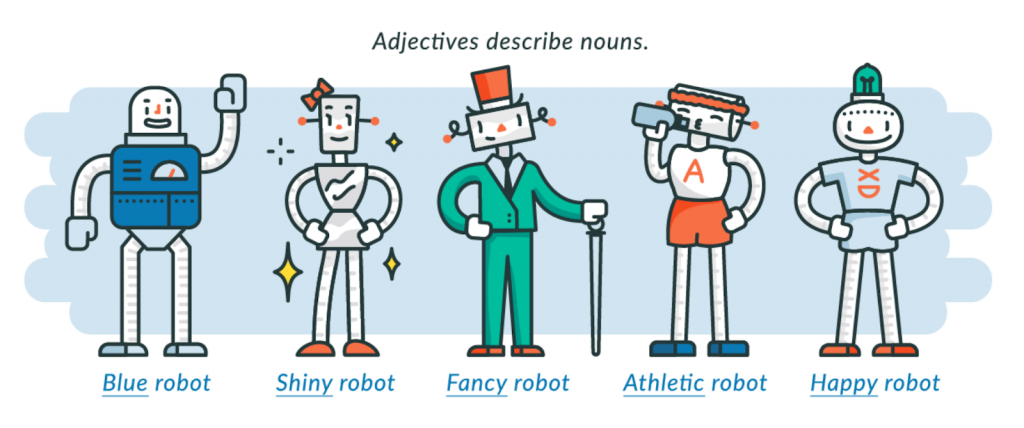
What is an Adjective?
Adjectives are words or word sets that modify (describe) a noun or pronoun. There are several different types of adjectives.

Return to Table of Contents
Types of Adjectives
Descriptive Adjectives
Descriptive adjectives describe qualities of a noun or pronoun and are the most commonly used type of adjective. There are two main types of descriptive adjectives: Attributive Adjectives and Predicate Adjectives.
Attributive Adjectives
Attributive adjectives are words, clauses, or phrases used directly before or after the noun or pronoun they are modifying and describe a quality of the word being modified.
- I bought berry pie when I went to the grocery store.
The word berry is modifying, or describing the type of pie. The word grocery is modifying the type of store.
- The snowflakes made my nose cold.
The word cold is modifying the word nose by describing it. In this example, the attributive adjective directly follows the noun being described.
Predicate Adjectives
Predicate adjectives are words, phrases, or clauses that modify the subject of a sentence or clause following a linking verb. They are called predicate adjectives because they are part of the sentence predicate.
- That building is gigantic!
The word gigantic is modifying the word building by describing its size following the linking verb is.
Coordinate Adjectives
Coordinate adjectives are two or more adjectives that work together to modify the same noun.
When using coordinate adjectives, commas or the word “and” must be used to separate the adjectives because each adjective is describing the noun.
- The energetic, mischievous Luna is our pet Husky.
The words energetic and mischievous are working together to describe Luna. If the comma was replaced with the word and, or the adjectives were reversed, it would not change the meaning of the sentence.
- The energetic and mischievous Luna is our pet Husky.
- The mischievous, energetic Luna is our pet Husky.
If your sentence doesn’t make sense, or the meaning is changed if you replace the comma with the word “and” or reverse the adjectives, you are probably using cumulative adjectives.
Cumulative Adjectives
Cumulative adjectives are two or more adjectives that have a building effect on the word being described, and the order of the adjectives are important to the overall meaning. Commas and/or the word “and” are not used with cumulative adjectives.
- That crazy large crimson Husky is our pet Luna.
In this sentence, the words crazy, large, and crimson are not independent descriptions of the noun. They work as a unit to describe the noun.
In this case, crimson is modifying Husky, large is modifying ‘crimson Husky’, and crazy is modifying ‘large crimson Husky’.

Limiting Adjectives
Limiting adjectives define nouns or pronouns by restricting them rather than describing them. They can be used to point out a specific object, set a number limit, and more.
There are nine types of limiting adjectives. We will review eight of these types, and the ninth type, Definite and Indefinite Articles, will be covered in another post.
Possessive Adjectives
Possessive Adjectives modify nouns by showing possession or ownership. Some of the most common possessive adjectives are: my, your, his, her, its, our, and their.
- I went to my room for some peace and quiet.
In this sentence, the word my is modifying the word room. It is possessive because it is showing ownership over the room.
- He went to the store to buy his groceries for the week.
In this sentence, the word his is modifying the word groceries. It is possessive because it is showing ownership over the groceries.
Demonstrative Adjectives
Demonstrative Adjectives are the same four words that make up demonstrative pronouns: this, that, these, and those, but used to modify nouns or noun phrases by indicating the position of the noun. This and that are used for singular nouns, and these and those are used for plural nouns.
- This restaurant is my favorite!
In this sentence, the word this is modifying the word restaurant. It is indicating that the singular noun, restaurant, is in close proximity to whomever is making the statement.
- Those buildings have a unique style.
In this sentence, the word those is modifying the word buildings. It is indicating that the plural noun, buildings, are at a further proximity to whomever is making the statement.
Indefinite Adjectives
Indefinite Adjectives are similar to indefinite pronouns, except that they modify nouns, pronouns, or noun phrases by describing an amount of them in a non-specific way.
- Many tourists visit the ancient ruins when visiting the Yucatán Peninsula.
Here, the word many is modifying the plural noun tourists. It is indicating that there are a large number of visitors, but it does not indicate a specific number.
- You will have a few minutes to complete the assessment.
In this sentence, the word few is modifying the noun minutes. It is indicating that there are only a small number of minutes, but it does not indicate a specific number.
Interrogative Adjectives
Interrogative adjectives are similar to interrogative pronouns, except they modify a noun or noun phrase by asking a question.
These are also known as interrogative determiners. There are three interrogative adjectives: What, Which, and Whose.
- Which subject is your favorite?
- What cuisine do you enjoy the most?
- Whose car is parked in front of the store?
In all of these examples, the interrogative adjective is asking a question about the subject, cuisine, and car.
Cardinal Adjectives
Cardinal Adjectives modify a noun by indicating a specific number of that noun.
- I have four books I want to read.
- There are nine classrooms down that hallway.
In these examples, the cardinal adjective is indicating a specific number of books and classrooms.
Nouns used as Adjectives
A noun can be used as an adjective when it is describing or specifying another noun.
- The game convention was sold out this year.
- That news reporter asked great questions.
In these examples, the nouns game and news are being used as adjectives to describe the type of convention and reporter.
Proper Adjectives
Proper Adjectives work the same way as nouns used as adjectives when the noun is a proper noun. Proper adjectives are capitalized just like proper nouns are.
- He wrote his play in a Shakespearean style.
- I could really go for a Caribbean getaway.
In these examples, the proper nouns Shakespearian and Caribbean are being used as adjectives to describe the type of style and getaway.
Return to Table of Contents
The Basics of Adverbs
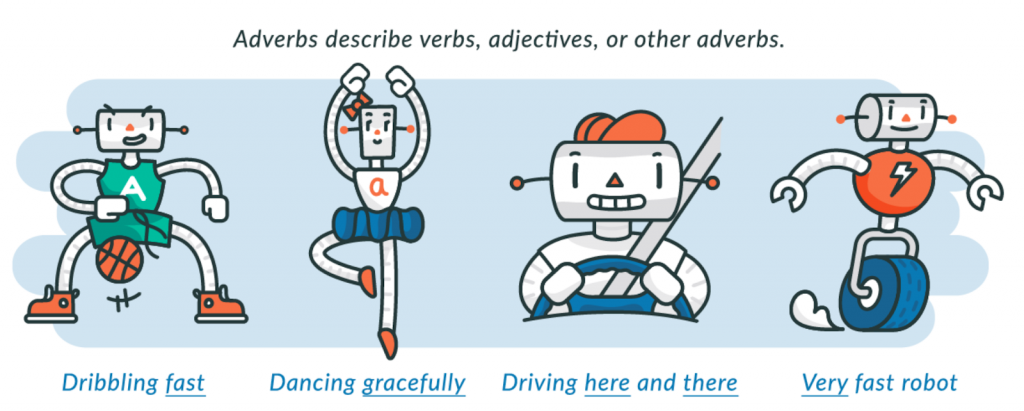
What is an Adverb?
Adverbs are words or sets of words that modify (describe) verbs, adjectives, or other adverbs. There are five main types of adverbs: degree, frequency, manner, place, and time.
Also, an adverb can be used as a conjunction when connecting ideas. These are called conjunctive adverbs, and will be discussed after reviewing the five main types of adverbs.

Return to Table of Contents
5 Main Types of Adverbs
Adverbs of Degree
Adverbs of degree tell us about the intensity of a verb, adverb, or adjective in a sentence. They tell us how much, or to what extent an action has been or will be done. When used to modify an adjective, they tell how much about a quality.
Modifying a verb:
- They are almost finished with their homework.
For this sentence, the adverb almost is modifying the verb finished.
Modifying an adverb:
- The car is moving too quickly for the bicycle to keep up.
Here, the adverb too is modifying the adverb quickly, which are working together to modify the verb moving.
Modifying an adjective:
- The pasta was extremely spicy.
In this sentence, the adverb extremely is modifying the adjective spicy, which are working together to modify the noun pasta.
Adverbs of Frequency
Adverbs of frequency tell us how often a verb is occurring. These adverbs usually appear between the subject and the verb, but they may appear at the beginning or end of the sentence.
Adverbs of frequency may be single words, phrases, general or specific.
Here, we will look at one sentence stem using a variety of adverbs of frequency:
- She occasionally volunteers at the animal shelter.
- Occasionally, she volunteers at the animal shelter.
- She volunteers at the animal shelter occasionally.
Adverbs of Manner
Adverbs of manner tell us how something is done. These are the most common adverbs, which primarily modify verbs, and end with an ‘ly’.
These adverbs are generally located after a verb or at the end of a verb phrase, but can appear before the verb or verb phrase.
- She stepped softly on the stairs.
- She softly stepped on the stairs.
Adverbs of Place
Adverbs of place tell us more about where a verb is taking place. They generally are located after the main verb or direct object of a sentence and are only used to modify verbs.
- I went there to find that popular holiday gift.
- On Black Friday, there are desperate parents everywhere!
Adverbs of Time
Adverbs of time tell us when a verb takes place. Adverbs of time are similar to adverbs of frequency, but they more explicitly say when, not how often. They can be located at the beginning or end of a sentence.
- I can’t wait to go on vacation tomorrow.
- Yesterday, she was able to walk home in the nice weather.
Conjunctive Adverbs
Conjunctive Adverbs connect two independent clauses or sentences with a transition word to show the relationship between one idea and the next.
The relationship between the two independent clauses show transitioning information that is: additional, contrasting, emphasising, resulting, or sequential. Conjunctive adverbs are often confused with coordinating conjunctions.
While coordinating conjunctions join two independent clauses, they require a comma before the conjunction and must be located where the two independent clauses meet.
Conjunctive adverbs are transitions, and they can be used at the beginning, middle, or end of a single independent clause.
A conjunctive adverb can be positioned a number of ways within the two independent clauses where a transition is being shown. Depending on where the transition word is being placed, different punctuation rules apply.
Pay close attention to the punctuation in the following sentences. All examples are correct ways to use coordinating adverbs:
- They searched for five hours. However, they could not find the extra set of car keys.
- They searched for five hours. They could not, however, find the extra set of car keys.
- They searched for five hours. They could not find the extra set of car keys, however.
- They searched for five hours; however, they could not find the extra set of car keys.
- They searched for five hours; they could not, however, find the extra set of car keys.
Pro Tip: Avoid a comma splice! Make sure you are able to identify two independent clauses when combining them with a coordinating adverb.
If you are making one sentence, there must be a semicolon before the coordinate adverb, and a comma after the coordinate adverb.
- Incorrect Example: They did not complete their chores today, consequently they could not go to the party.
- Correct Example: They did not complete their chores today; consequently, they could not go to the party.
In the incorrect example, the two independent clauses are combined with a coordinate adverb, but there is only a comma before the adverb.
In the correct example, there is a semicolon after the first clause, before the coordinating adverb, and a comma after the adverb.
Refer to Albert’s blog posts on commas and semicolons for more information on the use of commas and semicolons.
Return to Table of Contents
3 Tips for Recognizing and Using Adjectives and Adverbs
Tip #1: Know how to use the words ‘Good’ and ‘Well’
The words good and well are often misused.
- Good is an adjective.
- Well is an adverb that answers the question how. However, when discussing physical health, well is used as an adjective. When describing someone’s emotional state, use the word good.
Ask yourself what word am I modifying?
Look at the following examples:
- The flowers smell good.
Good is a predicate adjective modifying the noun flowers.
- He ran well today.
Well is an adverb modifying the verb ran.
- I feel good. — I feel well.
These are the most questioned uses of good and well. Which is correct? The answer is that BOTH can be correct!
- If someone asks you, “How do you feel?”, think about the context in which it’s being asked. Have you been sick? If so, you would want to use well in your response to indicate that you are not sick anymore. Have you been down or sad recently? If so, you would want to use good in your response to indicate that you are not sad now.
Tip #2: Know what word you want to modify
The location of a modifier can impact the meaning of the sentence and whether or not the modifier is an adjective or adverb.
The series of sentences below all mean different things depending on where the modifier is located.
- Even the dog avoided the meatloaf.
- The dog even avoided the meatloaf.
- The dog avoided even the meatloaf.
In the first sentence, the word even is modifying ‘the dog’, suggesting that a number of people avoided the meatloaf, including the dog.
In the second sentence, the word even is modifying the verb ‘avoided’, suggesting that the dog is avoiding a number of things, including the meatloaf.
In the third sentence, the word even is modifying ‘the meatloaf’, suggesting that the dog wouldn’t normally avoid the meatloaf, and something might not be right with the dog.
Tip #3: Always pay attention to words ending with ‘ly’
Most adverbs are well known for ending with the letters ‘ly’. Adding ‘ly’ to the end of an adjective very often changes that adjective to adverb.
- Note: depending on the ending of the adjective, some other rules will apply when converting the adjective to an ‘ly’ adverb. This is not a foolproof method of identifying an adverb, but it’s a good indicator that you should look at that word more closely.
As always, look closely to see what job the word is doing.
- That boy is silly.
In this sentence, the word silly is describing the boy, so this ‘ly’ word is an adjective.
- The assembly was held at the end of the day.
In this sentence, the word assembly is an event, so this ‘ly’ word is a noun.
- Knowing the job of a word will help you to identify which part of speech it is in a sentence.
Return to Table of Contents
Applying the Basics: Adjective and Adverb Review & Practice
Now that you understand what adjectives and adverbs are, and how to use them properly in a sentence, let’s practice identifying them and checking for proper usage.
Remember, adjectives are words that modify nouns and pronouns. They help to describe or tell us more about those nouns and pronouns. Adverbs are words that modify verbs, adjectives, and other adverbs.
They help to describe or tell us more about those verbs, adjectives, and other adverbs.
The Ultimate List of Descriptive Adjectives
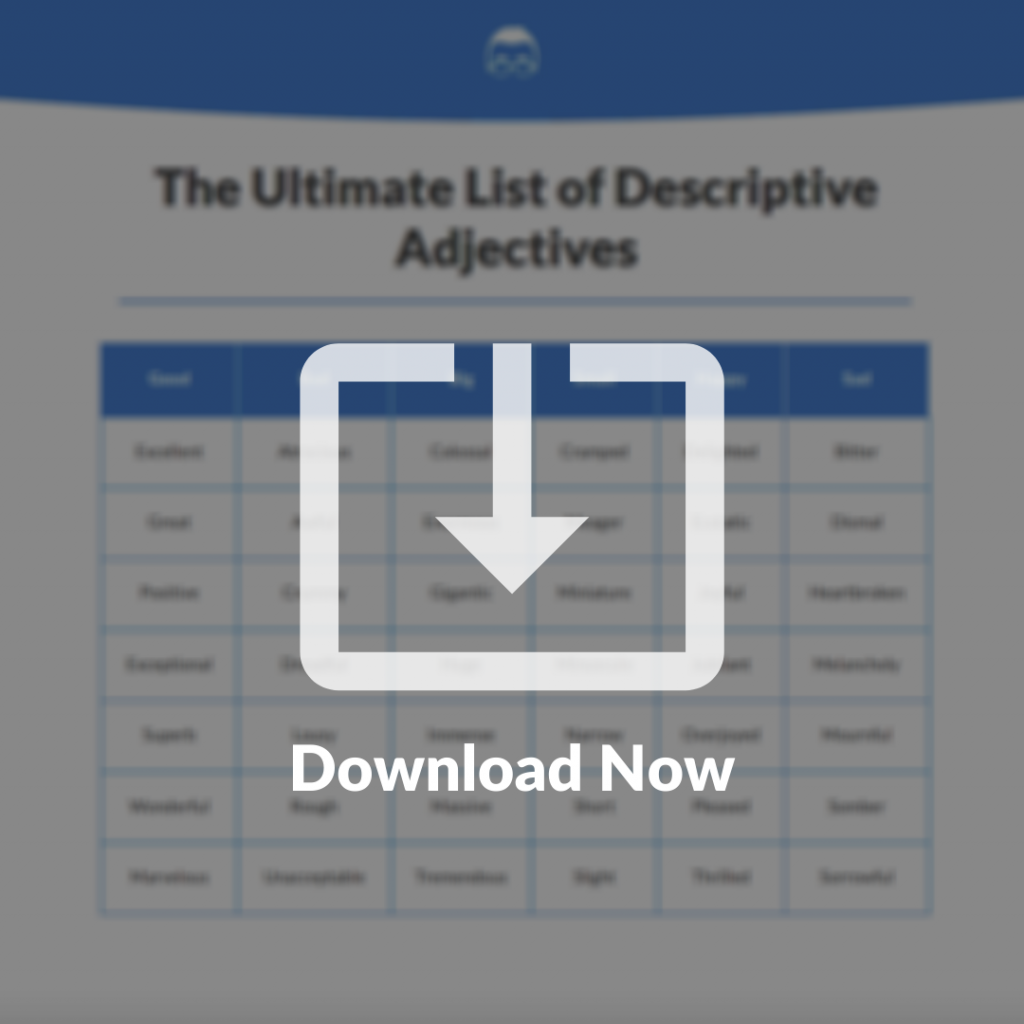
*Please note that this list does not include all descriptive adjectives.
The Ultimate List of Limiting Adjectives
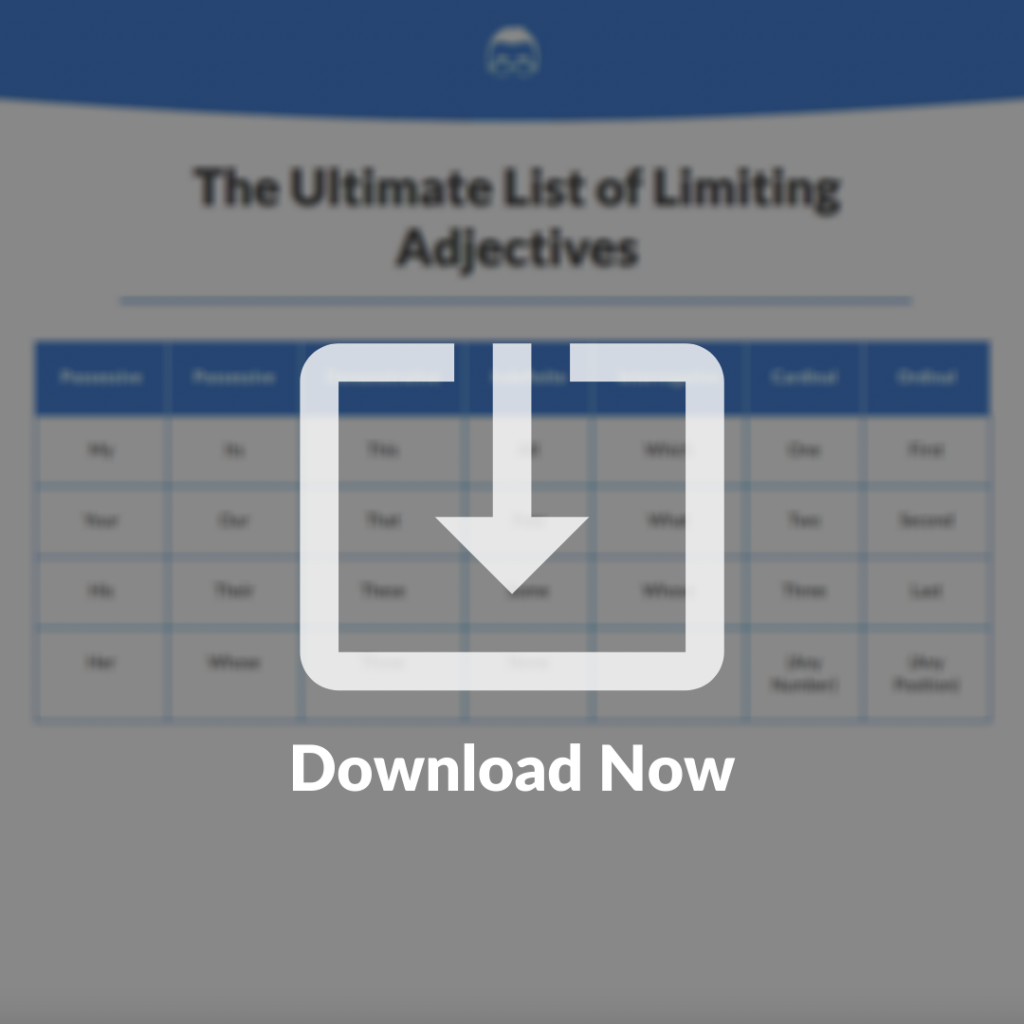
*Please note that this list does not include all limiting adjectives.
The Ultimate List of Adverbs
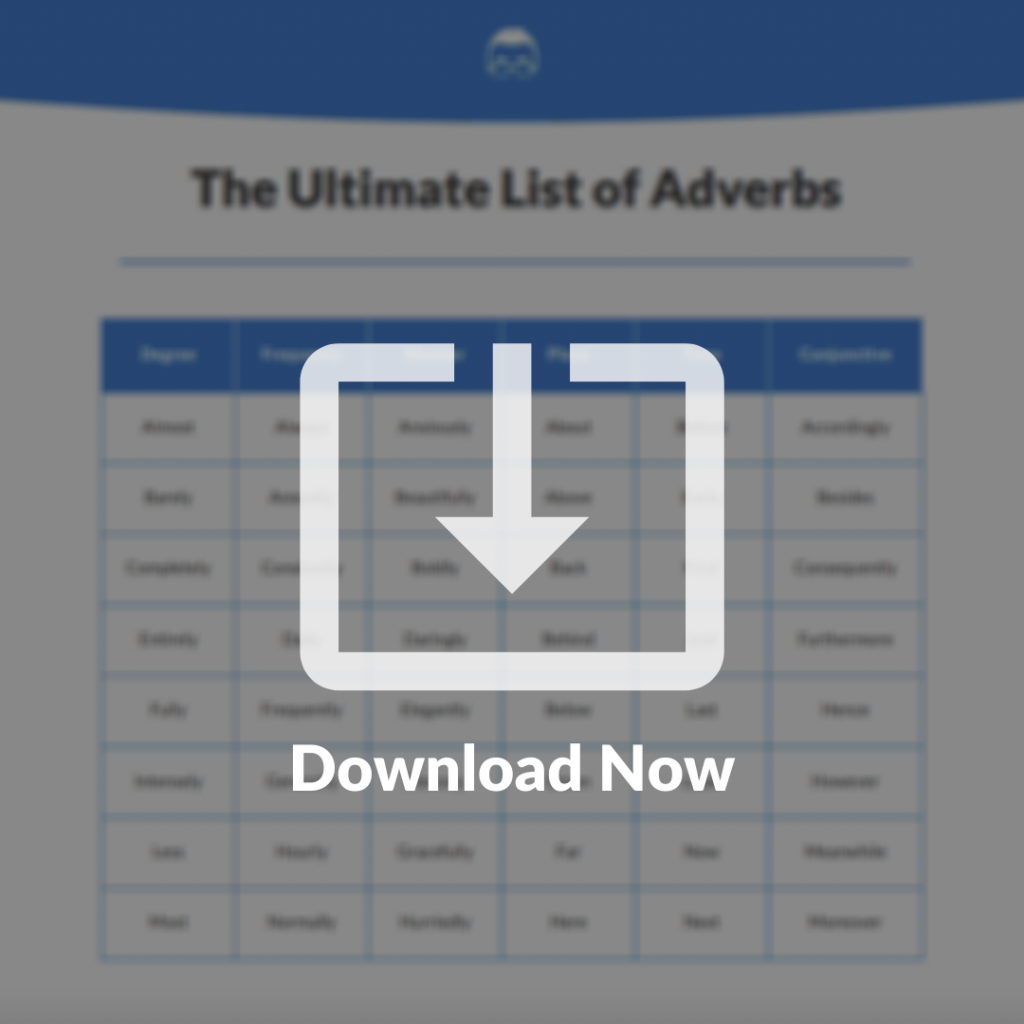
*Please note that this list does not include all adverbs.
Return to Table of Contents
Adjectives Exercises & Review
Complete the quick exercise below to assess your mastery of adjectives.
Select the adjective(s) in the sentences below. Remember, an adjective is a word that modifies a noun or pronoun. Adjectives can be descriptive or limiting
1. The ornate yellow house on the corner was the last house built in a Victorian style.
- Ornate modifies ‘yellow house’
- Yellow modifies house
- Last modifies house
- Victorian modifies style
2. Those younger kids with the soccer ball were slow getting to their homes by curfew.
- Those modifies ‘younger kids’
- Younger modifies kids
- Soccer modifies ball
- Slow modifies ‘those younger kids’
- Their modifies homes
3. My childhood home always brings back wonderful memories of good times with my family.
- My modifies ‘childhood home’
- Childhood modifies home
- Wonderful modifies memories
- Good modifies times
- My modifies family
4. The first time they won a basketball game, his team celebrated with a pizza party.
- First modifies time
- Basketball modifies game
- His modifies team
- Pizza modifies party
5. Which hotel from our tour of Western Europe was your favorite?
- Which modifies hotel
- Our modifies tour
- Western modifies Europe
- Your modifies favorite
For additional practice, check out the Adjective content on Albert.
Return to Table of Contents
Adverbs Exercises & Review
Complete the quick exercise below to assess your mastery of adverbs.
Select the adverb(s) in the sentences below. Remember, an adverb is a word that modifies a verb, adjective, or other adverbs.
1. My teacher usually gives too much homework every Friday; consequently, the weekends barely have time for relaxation.
- Usually modifies gives
- Too modifies much
- Every Friday modifies gives
- Consequently is a conjunctive adverb transitioning between two independent clauses
- Barely modifies have
2. The newly elected mayor wisely adopted a law that fairly punished swimmers at the beach if they littered there.
- Newly modifies elected
- Wisely modifies adopted
- Fairly modifies punished
- There modifies littered
3. The young girl always completes her work first; she could usually, therefore, enjoy her evenings.
- Always modifies completes
- First modifies completes
- Usually modifies enjoy
- Therefore is a conjunctive adverb transitioning between two independent clauses
4. Yesterday, the group of boys boldly approached the cliff’s edge and sprang fearlessly into the lake below.
- Yesterday collectively modifies the verbs in the sentence
- Boldly modifies approached
- Fearlessly modifies sprang
- Below modifies sprang
5. Normally, I struggle frantically to clean my room quickly, and my mom eventually tells me to do it again.
- Normally modifies struggle
- Frantically modifies struggle
- Quickly modifies clean
- Eventually modifies tells
- Again modifies do
For additional practice, check out the Adverbs & Conjunctive Adverbs content on Albert.
Return to Table of Contents
Try for Yourself: Adjective & Adverb Quiz
Feeling confident in your understanding of adjectives and adverbs?
Take this short quiz to see what you’ve learned:
1. Do adjectives or adverbs modify nouns and pronouns?
- Answer: Adjectives
- Correct Explanation: That’s right! Adjectives modify nouns and pronouns. Adverbs modify verbs, adjectives, and other adverbs.
- Incorrect Explanation: Sorry, that’s not right. Remember, Adverbs modify verbs, adjectives, and other adverbs. Adjectives modify nouns and pronouns.
2. Should the following sentence use the word good or well?
I didn’t sleep very (good/well) last night.
- Answer: Well
- Correct Explanation: That’s right! Since the being modified is a verb, sleep, the modifier needs to be an adverb. Well is an adverb and good is an adjective.
- Incorrect Explanation: Sorry, that’s not right. Remember, since the word being modified is a verb, sleep, the modifier needs to be an adverb. Well is an adverb and good is an adjective.
3. Which of the following sentences is accurately punctuated for the conjunctive adverb?
A. You must complete your dinner, otherwise; you won’t get desert.
B. You must complete your dinner; you won’t get desert, otherwise.
- Answer: B
- Correct Explanation: That’s right! When using a conjunctive adverb, a semicolon must separate the two independent clauses, and the conjunctive adverb must be offset with a comma.
- Incorrect Explanation: Sorry, that’s not right. Remember, a conjunctive adverb can be placed in various locations after the first independent clause, but you still must use a semicolon at the end of the first independent clause, and the conjunctive adverb must be offset with a comma.
4. Does the underlined section of the sentence below use cumulative adjectives or coordinate adjectives?
The wooden roller coaster was the first big ride at the theme park.
- Answer: Cumulative Adjectives
- Correct Explanation: That’s right! Cumulative adjectives build off one another. Their placement cannot be changed, and they are not separated by a comma.
- Incorrect Explanation: Sorry, that’s not right. Remember, coordinate adjectives equally modify a noun. They must be separated by a comma or the word ‘and’. Cumulative adjectives build off one another. Their placement cannot be changed, and they are not separated by a comma.
5. Does the following sentence use a descriptive or limiting adjective?
Most students ride the bus to school.
- Answer: Limiting Adjective
- Correct Explanation: That’s right! The adjective ‘Most’ is an indefinite adjective describing an amount in a non-specific way. Indefinite adjectives are limiting adjectives.
- Incorrect Explanation: Sorry, that’s not right. Descriptive adjectives describe a ‘quality’ of a noun or pronoun. ‘Most’ is an indefinite adjective describing an amount in a non-specific way. Indefinite adjectives are limiting adjectives.
6. Which answer is the best choice to make the underlined portion of the following sentence accurate?
The kids responded excited when they were told about the field trip.
A. respond excited
B. responded excitedly
- Answer: B
- Correct Explanation: That’s right! The word excited is meant to be an adverb modifying the verb responded. Changing excited to excitedly makes the sentence accurate.
- Incorrect Explanation: Sorry, that’s not right. Changing the tense of ‘responded’ to ‘respond’ makes the sentence further incorrect, as the rest of the sentence uses the past tense. For this sentence, the word excited is meant to be an adverb modifying the verb responded. Changing excited to excitedly makes the sentence accurate.
For additional practice with adjectives and adverbs, check out our practice on Albert.io: Adjectives, Adverbs, and Conjunctive Adverbs
Return to Table of Contents
Teacher’s Corner for Adjectives and Adverbs
While it’s true that adjectives and adverbs are a foundational grammar skill, the Common Core English Language Progressive Skills Chart shows that even elementary-level skills “require continued attention in higher grades as they are applied to increasingly sophisticated writing and speaking.”
For specific standards addressing adjectives and adverbs, check out the Common Core State Standards site!
Albert’s adjectives, adverbs, and conjunctive adverbs practice can be used for much more than homework!
Our assessments can be used as pre-and post-tests to measure student progress. Our pre-made quizzes can be used as bell-ringers, exit tickets, and more!
In addition to our pre-made assessments, you can also use our assignments feature to create your own quizzes and assessments.
Return to Table of Contents
Summary on Adjectives and Adverbs
An Adjective is a word that modifies a noun or pronoun. The two main types of adjectives are Descriptive Adjectives and Limiting Adjectives.
An Adverb is a word that modifies a verb, adjective, or other adverb. There are five main types of adverbs: Degree, Frequency, Manner, Place, and Time. Additionally, Conjunctive Adverbs are used to connect two independent clauses with a transitioning word.
Adjectives and adverbs are words we often see and use in our writing. Make sure you check your work carefully and know what the job these modifiers are doing when deciding what adjectives and adverbs to use.
Practice makes perfect! Use our Adjectives, Adverbs, and Conjunctive Adverbs practice on Albert’s grammar course!
Need help preparing for your Grammar exam?
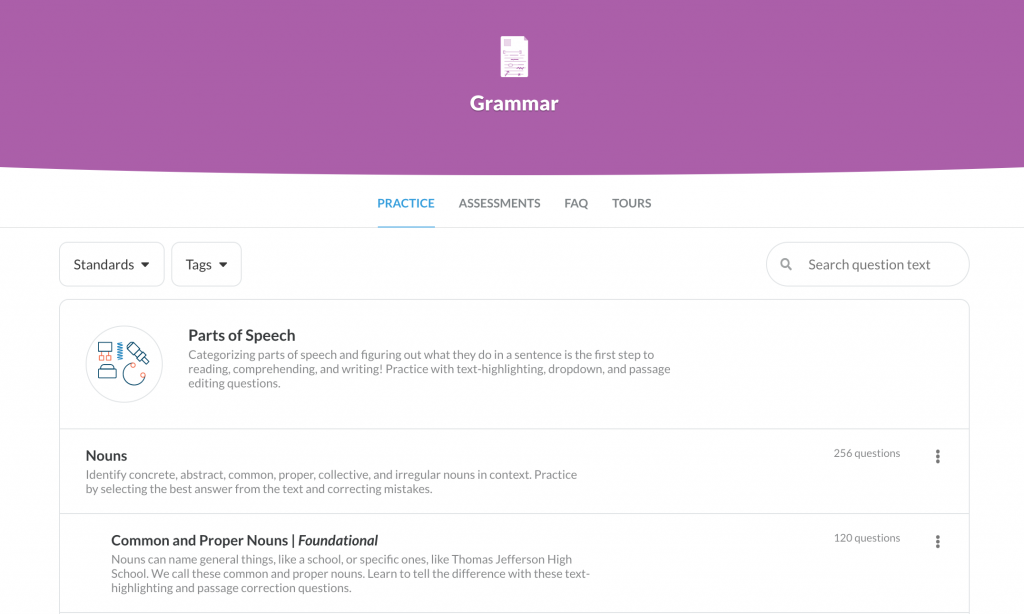
Albert has hundreds of grammar practice questions with detailed explanations to help you master concepts.
Understanding the difference between an adjective and an adverb can be confusing. The difference lies in what they describe – a noun or pronoun, or a verb, adjective or other adverbs.
What is an adjective?
An adjective is a word or set of words that describes a noun or pronoun.
Adjectives can come before the word they describe.
For example:
That is a cute hamster.
She likes a handsome man.
Adjectives can also follow the word they describe.
For example:
That kitten looks cute.
What is an adverb?
An adverb is a word or set of words that describes verbs, adjectives, or other adverbs. Adverbs answer how, when, where, why, how often or how much.
For example:
She walks slowly (tells how)
She walks very slowly (very – tells how slowly)
My cousin arrived today (tells when)
My cousin will arrive in an hour (this adverb phrase tells when)
We looked for her toy in the attic (tells where)
Adverbs and adjectives with the same form
There are a number of adjectives / adverbs that take the same form. It, therefore depends on the sentence context as to whether it is an adjective or an adverb.
The adjectives / adverbs that take the same form include:
fast, hard, early, late, high, low, right, wrong, straight and long.
For example:
Billy has a fast car. (Adjective)
Billy speaks fast. (Adverb)
Sue has an early start in the morning. (Adjective)
Sue starts early. (Adverb)
Good vs. well
Good and well are two words that tend to create confusion.
The hard and fast rule is:
Good is an adjective.
Well is an adverb.
For example:
Sarah is a good singer. (Adjective)
Sarah sings well. (Adverb)
Sometimes, though, we use well as an adjective when we are talking about health and well-being.
For example:
How are you today?
I’m well, thanks.

Become a Member
This content is available to members only.
Join K5 to save time, skip ads and access more content.
Learn More

